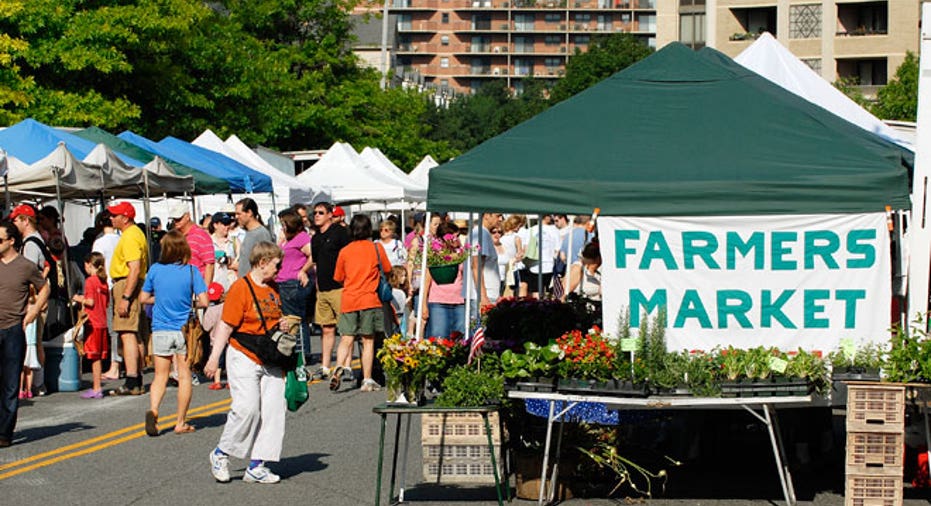Honeybees at Risk of Extinction? Or, a Lot of Buzz About Nothing?

The cold winter hasn’t just upset retailers trying to sell spring clothes.
The freezing temperatures have also led to shrinking honeybee populations in the U.S., according to George Hansen, president of the American Beekeeping Federation. This may seem like small potatoes – if not for the fact that honeybees pollinate $15 billion of U.S. crops, according to the USDA.
“We’re probably looking at 40% losses of colonies over this winter,” says George Hansen, the president of the American Beekeeping Federation.
Who’s Getting Stung? Beekeepers and honey producers say they’ll be the first to get stung by poor honeybee health.
Declining colony numbers are thought to be caused by a number of factors, including pesticides and the mysterious “Colony Collapse Disorder,” which Hansen says causes bees to suddenly disappear from the hive.
“I’ve seen a 65% loss over the winter … generally the loss would only range from 5% to 15%,” says Cathy Wolko of the Connecticut-based Humble Honey Bee Honey Company.
Wolko, whose products include both honey and honey-based skincare products, says she is spending over one-third of her operating budget on replacing honeybees that didn’t survive the winter.
“We are struggling,” Wolko says. “My business is very dependent on my honeybees.”
Hansen says the challenges to produce honey were already reflected in last year’s sales numbers.
“We sold 140 million pounds of honey last year, whereas 160 to 170 pounds would have been a more normal crop,” Hansen says.
But aside from producing honey and beeswax, honeybees play a strong role in the lifecycle of a number of U.S. crops. Each year, over two-thirds of the commercial honeybees find their way to California’s almond growers, which raise a $3.8 billion crop, according to Almond Board spokesman Robert Curtis.
Ray Henriques, the farm manager at Stewart and Jasper Orchards, says low honeybee supply has increased the cost of renting honeybees 50% over the past 5 years.
“We’re definitely worried – it’s always a concern,” says Henriques, noting that honeybee rentals cost the almond company about $600,000 this season.
But not everyone is concerned.
“The almond business has been very good, though,” says Monte Vista Farming Company COO Jonathan Hoff. “If the market had been difficult and prices for almonds had been lower, that probably would have caused folks to cut down the average of two hives per acre to a hive and a half,” he says, which may have led to a diminished almond crop.
Crops around the country, including apples, pears and berries, are also pollinated by honeybees and may be affected by weak hives. Connecticut Apiary Inspector Mark Creighton, who monitors hive health around the state, says this year may be the first time the Constitution State will need to bring in honeybees from other states to pollinate crops.
“33% of our food items are pollinated by honeybees,” says Creighton. “What would our diet look like without 33% of our produce?”
Dr. Jennifer Sass, a senior scientist at the Natural Resources Defense Council, a non-partisan environmental advocacy group based in New York City, paints a very scary picture of what this loss could mean to the United States.
“Experts have predicted food shortages, just from the loss of pollinators,” says Dr. Sass, who says this dire forecast comes from an unnamed expert at the EPA.
“Pollinator decline is one of the biggest security threats we’re facing in this country, because it compromises the ability to grow our own food,” says Sass.
Could These Predictions Be Overblown? “It’s just hype, it’s just phony – there’s no decline,” says Dan Sumner, an agricultural economist at UC Davis. He says the true problem has been the expansion of the almond crop. As a result, he says beekeepers are having a hard time meeting the demand so early in the season; almond trees are pollinated in February and March, when it’s still very cold for the bees.
“We have about 800,000 acres of almonds to pollinate at an average rate of two colonies per acre,” says Dr. Eric Mussen, an apiculturist at UC Davis. “That is over a million and a half colonies that have to be here and ready to go in February, which is ‘winter’ to our temperate climate bees.”
He’s not alone in his thinking.
“CCD comes and goes,” says Sumner, disputing the claim that it’s a worsening issue. “And beekeepers have shown that they can just start a new hive.”
Scott Swinton, an agricultural economist at Michigan State University, agrees with Sumner and Mussen.
“Early reports tend to be alarmist,” he says, responding to claims that 50% of hives have failed to survive this year’s winter. “The impact is most serious on those that need to be pollinated earliest in the season,” he says, which is why the almond community makes such a big deal over poor honeybee health.
Looking at crops besides almonds, Mussen says recorded declines in honeybee colonies has yet to cause problems in U.S. crop production. He says there may be a cyclical rise and fall of honeybees every other year, with odd years showing an increase in honeybee colonies.
“We’ll see if this year things are a bit better, again,” says Mussen.
Meanwhile, some farmers are optimistic they will be able to use other methods to pollinate their crops, regardless of the fate of honeybees. For one, Sumner says scientists are working on self-pollinating almond trees that wouldn’t need honeybees at all.
And organic farmers, like Stephenie Caughlin of Sea Breeze Organic Farm in San Diego, says she’s taken pains to build a complete ecosystem, which attracts other natural pollinators, like birds, moths, praying mantises and butterflies.
Tom Rosenfeld, of Earth First Farms, has also built a self-sustaining environment on his farm in Michigan, which grows organic apples and vegetables 100 miles from Chicago.
“We’ve figured out a way around the honeybee problem – we’ve broken our dependence with the honeybee,” says Rosenfeld.